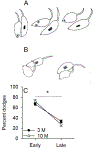Age-related changes in the organization of spontaneously occurring behaviors
- PMID: 35901935
- PMCID: PMC10436331
- DOI: 10.1016/j.beproc.2022.104713
Age-related changes in the organization of spontaneously occurring behaviors
Abstract
Age-related changes in spatial and temporal processing have been documented across a range of species. Rodent studies typically investigate differences in performance between adult and senescent animals; however, progressive loss of neurons in the hippocampus and cortex has been observed to occur as early as after adolescence. Therefore, the current study evaluated the effects of age in three- and ten-month-old female rats on the organization of movement in open field and food protection behaviors, two tasks that have previously dissociated hippocampal and cortical pathology. Age-related differences were observed in general measures of locomotion, spatial orientation, and attentional processing. The results of the current study are consistent with age-related changes in the processing of spatial information and motivation that occur earlier in life than previously anticipated. These observations establish a foundation for future studies evaluating interventions that influence these age-related differences in performance.
Keywords: Exploration; Food protection; Movement kinematics; Open field; Rats; Senescence.
Copyright © 2022 Elsevier B.V. All rights reserved.
Figures







Similar articles
-
Role of active movement in place-specific firing of hippocampal neurons.Hippocampus. 2005;15(1):8-17. doi: 10.1002/hipo.20023. Hippocampus. 2005. PMID: 15390169
-
Locomotion-induced hippocampal theta is independent of visual information in rats during movement through a pipe.Behav Brain Res. 2011 Jan 20;216(2):699-704. doi: 10.1016/j.bbr.2010.09.021. Epub 2010 Oct 1. Behav Brain Res. 2011. PMID: 20888366
-
Idiothetic signal processing and spatial orientation in patients with unilateral hippocampal sclerosis.J Neurophysiol. 2018 Sep 1;120(3):1256-1263. doi: 10.1152/jn.00016.2018. Epub 2018 Jun 13. J Neurophysiol. 2018. PMID: 29897863
-
Parallel processing across neural systems: implications for a multiple memory system hypothesis.Neurobiol Learn Mem. 2004 Nov;82(3):278-98. doi: 10.1016/j.nlm.2004.07.007. Neurobiol Learn Mem. 2004. PMID: 15464410 Review.
-
Role of the hippocampus in temporal and spatial navigation: an adaptive neural network.Behav Brain Res. 1990 Aug 20;39(3):205-29. doi: 10.1016/0166-4328(90)90028-d. Behav Brain Res. 1990. PMID: 2244969 Review.
Cited by
-
Galactic Cosmic Irradiation Alters Acute and Delayed Species-Typical Behavior in Male and Female Mice.Life (Basel). 2023 May 19;13(5):1214. doi: 10.3390/life13051214. Life (Basel). 2023. PMID: 37240858 Free PMC article.
References
-
- Ayyildiz M, Kozan R, Agar E, & Kaplan S (2008). Sexual dimorphism in the medial vestibular nucleus of adult rats: stereological study. Anatomical science international, 83(3), 131–139. - PubMed
-
- Banovetz MT, Lake RI, Blackwell AA, Oltmanns JRO, Schaeffer EA, Yoder RM, & Wallace DG (2021). Effects of acquired vestibular pathology on the organization of mouse exploratory behavior. Experimental Brain Research, 1–15. - PubMed
MeSH terms
Grants and funding
LinkOut - more resources
Full Text Sources

